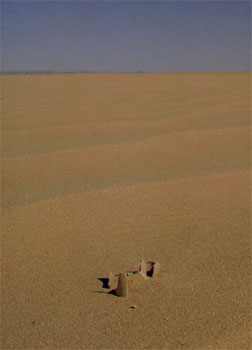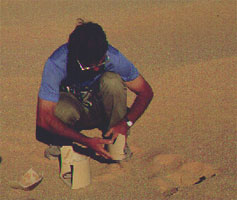

August 2001 - New information from Stuart Disbrey
|
During the 1998 November expedition, an attempt was made to locate the site of "Chianti Camp" of the 1932 Almásy - Clayton expedition, approximately 20km to the NW of Wadi Sora. The location is on a sandy plain, which is heavily marked by the tracks of the Kufra supply convoys of 1941-42. The area is littered with empty petrol tins, and occasional other WWII era artifacts. We were unable to locate the camp site though nerby a large rectangle marked with petrol tins along its side may have been the 1932 landing ground, but equally it could have been used during WWII, as several similar rectangles have been observed along the Kufra supply route. |
 |
 |
Near the south east corner of the landing ground a shattered stoneware jar was found half burried in the sand. On excavation, the bottom markings clearly showed it's English make, but gave no other clue as for it's age or purpose. As the location was close to Chianti camp, and many of the supplies were probably British, a link with the 1932 expedition could not be ruled out. The pieces were collected for later assembly and study. On reconstruction a white cylindrical jar emerged with a brown conical top, with the letters S.R.D. printed on the brown area. The base carries a seal, "Gibbs & Ganning Ltd., Tamworth, STAFFS. " |
 |
 |
|
|
Initial research showed the Jar was manufactured in Tamworth, Staffordshire, however Gibbs & Ganning Ltd. could not be located. After several unsuccessfull attempts to find out the jars age and purpose, the jar was described to Jack Valenti, President of the LRDG Preservation Society, who immediately recongised it: |
"From your description it has got to be a "Rum Jar".
When Major Bagnold formed the LRDG he requested that his men be permitted to have a rum ration (to fend off those cold nights). And it was approved. My understanding is that they were packed two jugs to a wooden case (with saw dust to protect them from breaking). I also understand that they had to account for all the jars, ie. if they were lost or broken in combat.
The IWM has a good photo of 3 LRDG members with Rum Jar and case. It is their (IWM) # E12371. The caption reads "One of the most precious items carried is Rum, very necessary for the bitterly cold nights of the desert."
I have yet to find out exactly just what the "SRD" means. One meaning was suggested as "Supply - Rum - Diluted" but I have been unable to verify this."
Some months later I was able to collect the actual photo from the Imperial War Museum, London (photo reproduced with permission) taken by Lt. Graham (probably at LRDG HQ. in Siwa) on the 25th of May, 1942:

Correspondence with Stuart Disbrey
Sent: Wednesday, August 01, 2001 10:44 AM
Subject: Rum Jar
... The rum jar you found was manufactured by Gibbs & Canning (not Ganning) of Glascote, Tamworth, Staffordshire. This company was set up around 1847 and by 1896 had its own coal mine to provide fuel for its kilns. Gibbs & Canning specialised in the production of architectural terracotta, garden ceramics and tiles - providing decorative tiles for many famous British buildings built during the Victorian and Edwardian era, perhaps most famously for the Natural History Museum in London, built in 1892 - and also produced sanitary goods, bricks, chimney pots, sinks and, as your rum jar proves, stoneware (not earthenware). I have not been able to discover when exactly the company went out of business but it appears to have ceased trading by 1930 - most probably a victim of the global economic depression which struck around that time. Standard rum jars held one gallon (about four litres) of liquid. The lettering SRD printed on the shoulder of the bottle stands for Supply Reserve Depot - which was the military base supply depot in the UK from which all such bottles were issued.
The rum jar you discovered may well have been used by the Long Range Desert Group - but this is by no means certain. The LRDG were not the only British military personnel to have a rum ration during World War Two. If the 1932 expedition which you mention on your website had any kind of military input - as I believe many of these types of expedition did - the jar could well have come from that. (note: while Penderel did come from the RAF, the bulkiness and fragility of these jars would have made this very unlikely, the more practical petrol tins were used for this purpose by all expeditions)
Rum jar is a misleading title as these jars were used to store many other liquids besides rum - including acids, oils and even ink. They were also used, unofficially, to store water. Perhaps a truck driver on the Kufra supply route during World War Two filled an empty rum jar with water for the journey and then discarded it in the sand once it was empty. Who knows? (note: I recently learned that the British personnel of the Kufra supply convoys and the Kufra Garrison of the SDF had LRDG Rations issues - as the jar was found right beside the convoy route, this could be a very likely origin.)
Gibbs & Canning was not a major manufacturer of rum jars, so the bottle you found is quite rare. I have a collection of about 50 rum jars but have yet to find one made by them. ...
Sent: Thursday, August 02, 2001 6:15 PM
Subject: Rum Jar
... There is no contradiction in the jar still being in service after the maker had gone out of business. Supply Reserve Depots held stocks of empty jars that could be filled and sent out as required. The shelf life of the contents - be they rum or ink - was often quite lengthy, so, even when the jars were full, they could sit around in storage for years. Once empty they were often re-used for other purposes by the troops in the field and, by the nature of their construction, they were sturdy and likely to survive harsh treatment (I have examples in my collection that are over 100 years old and are in perfect condition). The Royal Navy refilled its jars, which might also account for the extended service life of a jar. ...
Sent: Monday, August 13, 2001 2:29 PM
Subject: Rum Jar photo
... I've just been back to your website to look at the Imperial War Museum photo you have of British troops unpacking rum jars.
I thought you might be interested to know that, judging by the extent of the darker glaze around the shoulders of the jar and the size and spacing of the SRD lettering, the rum jar being held by the young soldier wearing glasses in the centre of the picture was made by the company of Price, based in Bristol, who were manufacturing rum jars up to the start of the Second World War. It's quite easy to spot the differences between this and the Gibbs & Canning jar that you found. ...
Sent: Friday, August 17, 2001 6:33 PM
Subject: Rum Jar
You might like to mention that it is now a well recognised medical fact that using alcohol to combat cold and exposure is absolutely the WRONG thing to do. So the LRDG boys weren't doing themselves any favours.
Nor, of course, do strong spirits tend to make people more alert, more able to make decisions quickly and clearly, or more able to stay awake! With all this in mind, the British Armed Forces stopped issuing rum to its personnel more than 30 years ago. ...
Sent: Wednesday, July 24, 2002 10:52 AM
Subject: The meaning of SRD
Steve/Andras - Thanks for forwarding e-mail regarding the meaning of the SRD acronym on British armed forces' rum jars. 'Services Rum Diluted' is a very oft-encountered explanation for the lettering (I have even seen it stated in some quite learned literature) but, I'm afraid, it is totally erroneous. Here's why:
1) There was never any such liquid as 'Services' rum - all rum consumed by British and Commonwealth forces was, in fact, Navy rum. So, for this explanation to be correct, the acronym would have to be NRD.
2) Rum was not stored in diluted form. Land-based forces generally received their rum ration neat, from the jar. For the Navy, the rum tot was diluted on issue to the individual - not before - in which case it was termed 'grog', that is watered-down neat rum. So again, the explanation of the D standing for 'Diluted' cannot be correct.
3) So-called 'rum jars' were used not only for the storage, transportation and distribution of rum, but also for a number of other liquid commodities including acids, alkalis, oils and even ink. Hence the R in the acronym cannot stand for 'Rum'.
4) The SRD acronym was used on a number of other official British military storage vessels - crates, boxes, etc - with no association with rum or any other liquids, whatsoever.
5) I have seen - and the Imperial War Museum in London has in its collection - sealed rum jars with the words 'Supply Reserve Depot' actually moulded into the official wax seal.
6) I have spoken with a number of former Royal Army Service Corps storesmen with experience going back to World War Two who are unanimous in stating that the SRD acronym stands for Supply Reserve Depot. And they should know!
7) Steve is partly correct in stating that there was not a single Supply Reserve Depot (though during World War One there was - at Deptford, London). By the end of World War Two there were, I believe, five SRDs. Three were in the UK, one was in Germany and one was in the Far East. The Deptford SRD was closed down in 1940 because of fears of Nazi invasion and air raids. The SRDs were pretty much the 'top tier' of the British supply system with a number of 'echelons' of supply bases getting progressively smaller and more local in influence as they neared the front line, from Base Supply Depots downwards. Much of the rum supply for the war in North Africa was, I believe, stored in Tobruk. I have read accounts of the supplies being poured away and/or polluted with petrol and oil to prevent them falling into the hands of the advancing Afrika Korps.
Stuart, many thanks for sharing all these details with us!